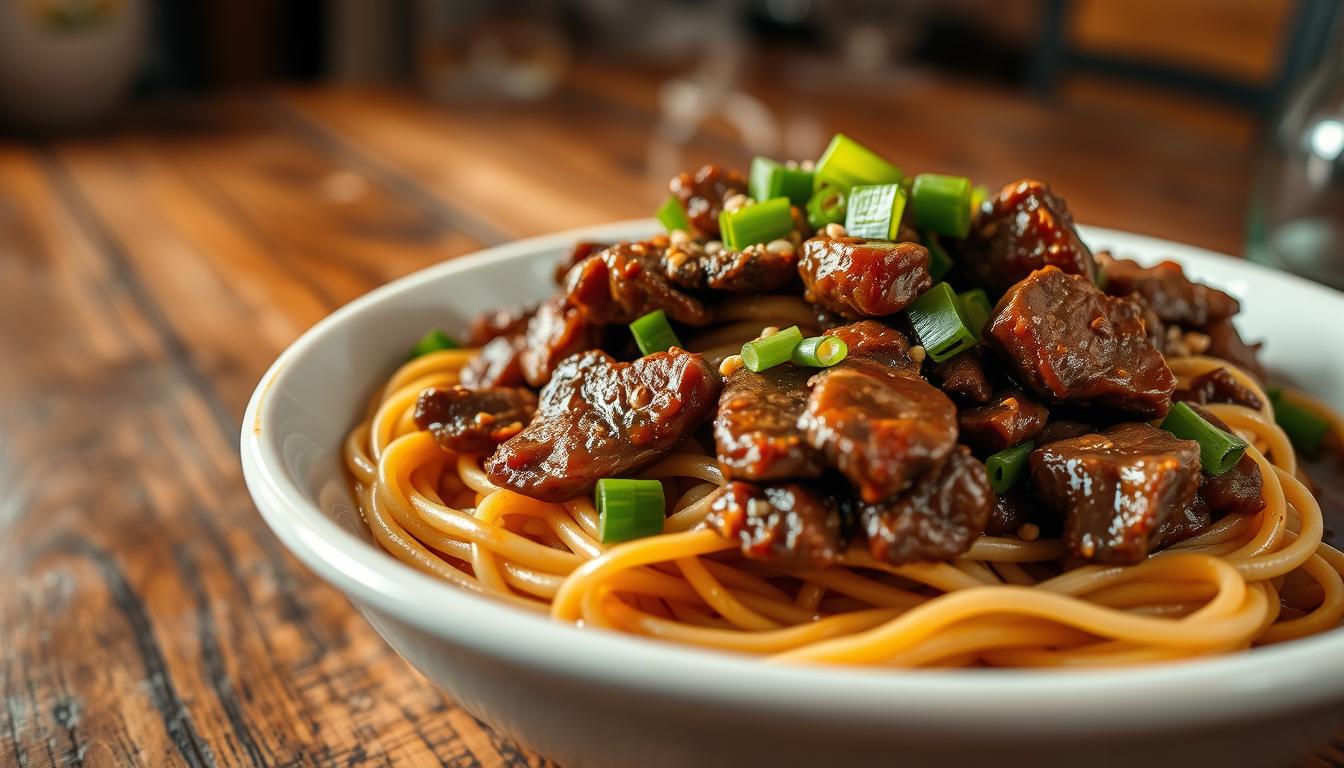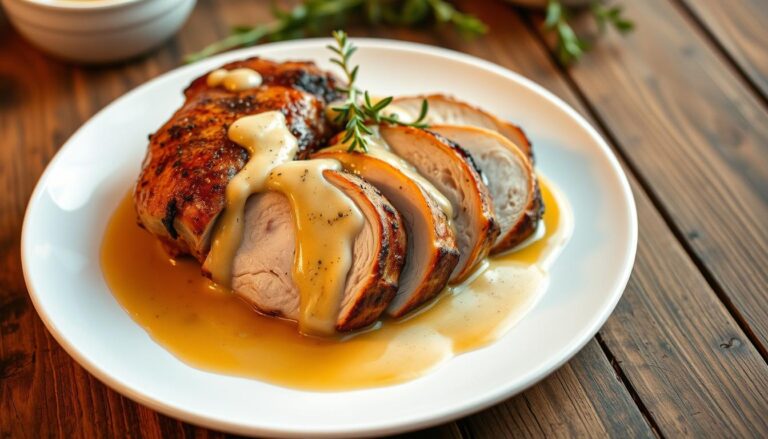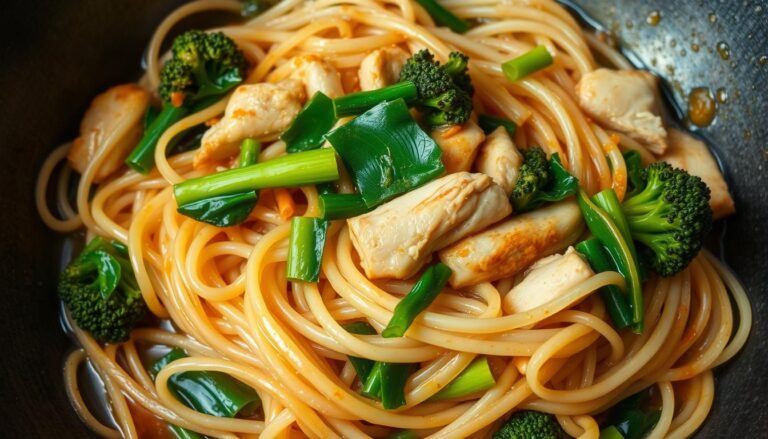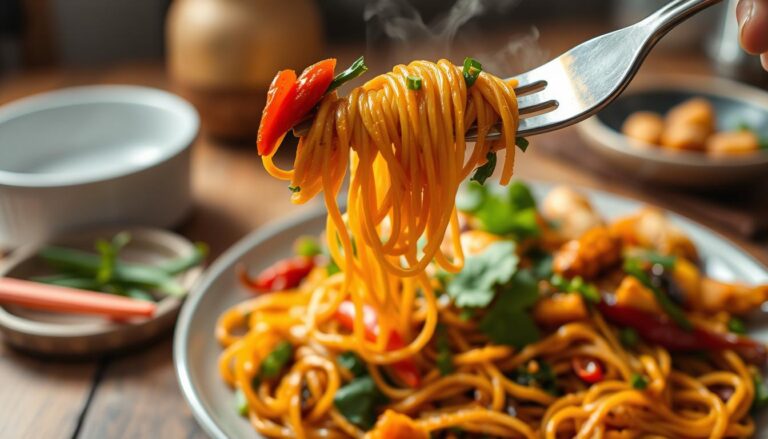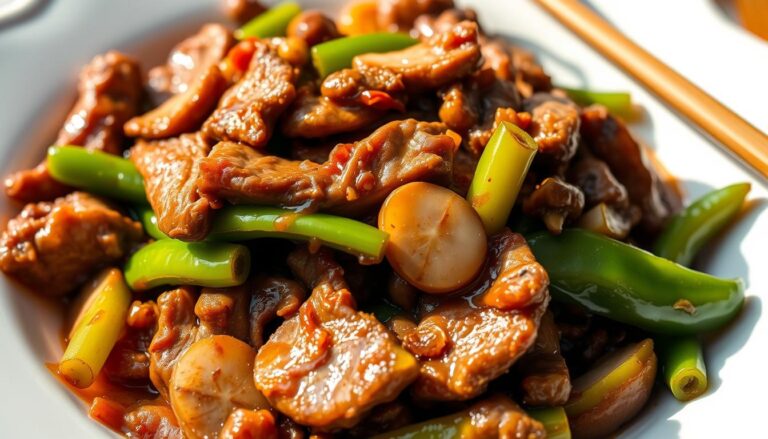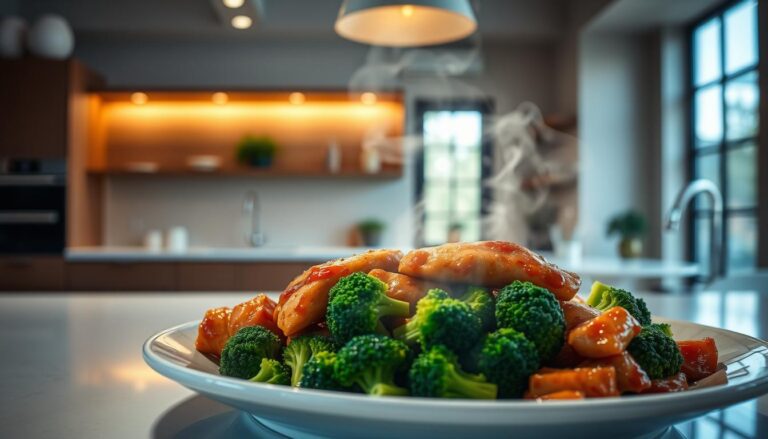Easy Quick & Savory Mongolian Noodles Recipe
Craving restaurant-quality flavors without the hassle? This hearty dish brings the bold taste of Mongolian cuisine to your kitchen in just 15 minutes. Perfect for busy nights, it combines tender ground beef with savory sauces and chewy noodles for a meal that feels indulgent yet effortless.
What makes this recipe stand out? It uses pantry staples you likely already have, like soy sauce, brown sugar, and garlic. The secret lies in balancing sweet, salty, and umami flavors – a hallmark of authentic Mongolian-inspired dishes. I first tried a version of this at a local eatery years ago and spent months perfecting my simplified weeknight adaptation.
You’ll love how the ground beef cooks quickly while absorbing the rich sauce. No specialty stores or complicated techniques needed here. Whether you’re feeding hungry kids or need a satisfying solo dinner, this flexible dish adapts to your schedule and taste preferences.
Key Takeaways
- Ready in under 20 minutes using common ingredients
- Features the signature sweet-savory flavor profile of Mongolian cuisine
- Easy to customize with vegetables or protein substitutes
- Uses ground beef for faster cooking than traditional sliced steak
- Includes tips for adjusting spice levels and sauce thickness
Ingredients Overview & Preparation
Your kitchen essentials hold the secret to recreating this Asian-inspired favorite. Let’s break down what you’ll need and why each element matters – plus smart swaps for dietary needs or pantry gaps.
Essential Ingredients and Substitutions
The sauce’s rich flavor comes from soy sauce (low-sodium recommended) mingling with sweet brown sugar and earthy hoisin. Fresh garlic and ginger add aromatic depth, while cornstarch thickens the glaze to perfection. Ground beef cooks faster than steak, but shredded chicken works beautifully too.
No rice noodles? Use linguine or spaghetti. Vegetarian? Swap beef for mushrooms or tofu. The key is maintaining the sweet-salty balance – adjust honey or chili flakes to taste. Always opt for fresh aromatics when possible; they pack three times more flavor than dried versions.
Required Equipment and Tools
A large skillet ensures even browning for your protein, while a pasta pan handles noodles without sticking. Measuring spoons guarantee sauce consistency – too much cornstarch makes it gummy. Pro tip: Chop all ingredients before heating pans. This mise en place approach turns hectic cooking into smooth assembly.
Don’t overlook your wooden spoon – it scrapes up flavorful browned bits better than metal utensils. With these basics, you’re 90 seconds away from restaurant-worthy results. Now let’s transform these components into something extraordinary.
Step-by-Step quick-savory-mongolian-noodles-recipe Instructions
Let’s fire up the stove and build layers of flavor in under 20 minutes. This process transforms basic ingredients into a glossy, restaurant-worthy meal through three key stages: browning, simmering, and tossing. Keep your skillet handy – it’s about to become your flavor-building powerhouse.
Initial Cooking Process: Browning and Simmering
Heat your skillet over medium-high and add ground beef. Break it into small crumbles using a wooden spoon. Once browned (about 4 minutes), drain excess fat but leave those flavorful bits. This step creates the foundation for your sauce.
Reduce heat to medium. Pour in ¼ cup soy sauce, 2 tablespoons brown sugar, and 1 teaspoon hoisin. Stir until the sugar dissolves. Add minced cloves garlic and ginger now – their aroma will bloom in the heat. For thickness, mix 1 tablespoon cornstarch with 2 tablespoons water, then whisk into the simmering liquid.
Final Assembly and Garnishing Tips
Add cooked noodles directly to the skillet. Toss until every strand wears that shiny sauce coat. Want to make mongolian-style magic? Finish with sliced scallions and sesame seeds. For extra zing, drizzle chili oil sparingly over your beef noodles.
Pro tip: Let the dish rest 2 minutes off heat. This lets the sauce cling better to the noodles. Serve in shallow bowls with chopsticks – because presentation matters as much as taste.
Tips for Authentic Flavor and Variations
Discover how simple swaps can bring authentic Asian flair to your kitchen. Whether adapting for dietary needs or chasing richer flavors, these tweaks keep the dish’s soul while letting your creativity shine.
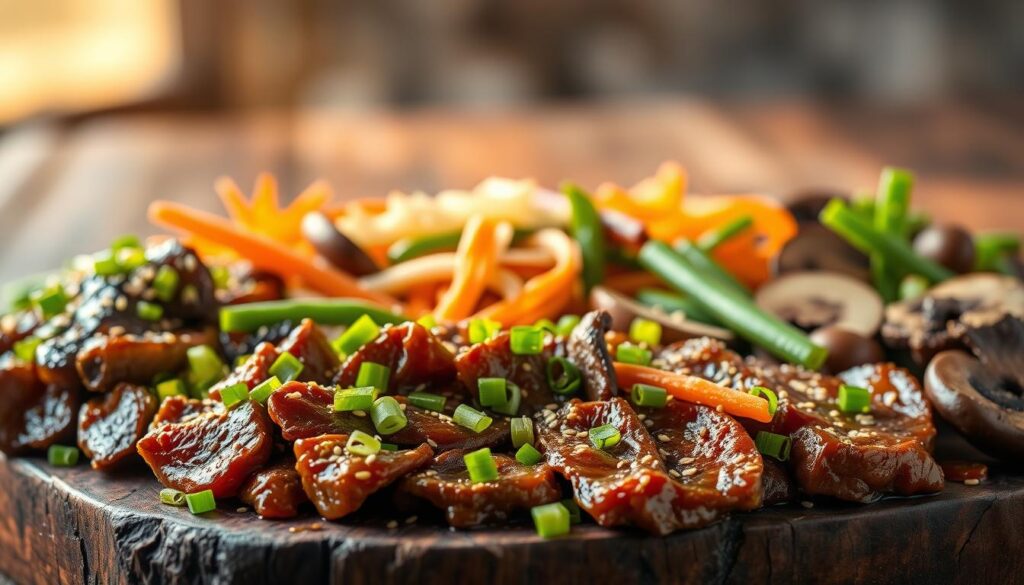
Protein and Noodle Flexibility
Swap ground beef for chicken breast or steak slices to match traditional preparations. Thinly sliced flank steak mimics classic mongolian beef textures when seared quickly. For plant-based versions, marinated portobello mushrooms absorb sauce beautifully.
Rice noodles create gluten-free authenticity, while udon adds chewiness. Cook them in less water than package instructions suggest – starchier cooking liquid thickens sauces naturally. Always rinse noodles after boiling to prevent clumping.
Sauce Customization Secrets
Balance sodium levels by mixing dark soy for color with low-sodium versions for taste. Caramelized onions or scallion whites deepen savory notes when sautéed before adding meat. A splash of rice vinegar cuts through richness without overpowering.
Control fat content by skimming excess oil after browning meats. For glossy results, let sauces reduce by 25% before tossing with noodles. A teaspoon of cornstarch slurry adjusts thickness without altering flavors.
Remember: The best versions reflect your palate. Add toasted sesame seeds for crunch or chili crisp for heat. Every tweak preserves the dish’s core – bold satisfaction in minutes.
Nutritional Info and Cooking Time Details
Understanding what fuels your meal helps balance indulgence with smart choices. Each serving packs 380-455 calories, making it a satisfying dinner without overloading your day. You’ll get 32g carbs for energy, 24g protein from meat, and 18g fats – a mix that keeps you full for hours.
Follow instructions closely when measuring ingredients like soy sauce and red pepper flakes. A ¼ teaspoon variance in spices can shift flavors from mild to fiery. Using 90% lean mongolian ground beef instead of 80% reduces fat by 5g per serving while keeping richness intact.
Mastering the Clock and Leftovers
Total active time stays under 15 minutes if you prep ingredients first. Brown meat for 4 minutes, simmer sauce for 3, and toss everything in 2. Leftovers? Reheat in a skillet with a splash of water to revive the glossy texture microwaves ruin.
Swap regular brown ground beef for leaner options if watching sodium. The dish’s 850mg per serving comes mainly from soy sauce – use low-sodium versions to cut it by 30%. Adjust red pepper quantities gradually; you can always add heat but can’t remove it once stirred in.
Sticking to these instructions ensures every bite delivers the intended harmony of sweet, salty, and spicy. Your dinner stays nutritious without sacrificing the boldness that makes this dish memorable.
Conclusion
Experience the magic of Mongolian-inspired cuisine at home with this crowd-pleasing creation. The harmony of pepper flakes, hoisin sauce, and black pepper delivers bold flavors faster than takeout. Don’t skip the final flourish – crisp green onions add freshness, while a quick toss in the large skillet ensures every bite glistens.
Success starts with precision: measure 1/4 cup portions for balanced seasoning and sear mongolian ground beef in your trusty pan. That sizzling ginger garlic base? It’s your flavor anchor. Swap proteins or noodles freely – the sauce adapts beautifully to your pantry.
Ready to make it yours? Whip up this noodles recipe, then share your twist. Bookmark this guide for future kitchen wins, and tag your creations to inspire fellow food lovers. Every sprinkle of pepper flakes and drizzle of hoisin sauce proves gourmet meals needn’t be complicated – just crafted with care.
FAQ
Can I use a substitute for soy sauce in this recipe?
Yes, coconut aminos or tamari work well as gluten-free alternatives. For a lower-sodium option, opt for reduced-sodium soy sauce. Adjust the quantity based on taste preferences.
What cuts of beef work best for Mongolian noodles?
Flank steak or sirloin are ideal for their tenderness and quick cooking time. For ground beef, choose 85% lean to balance flavor without excess grease.
How can I adjust the spice level in the sauce?
Control heat by reducing or omitting red pepper flakes. Add a dash of sriracha or chili oil at the end for a customizable kick without overpowering the dish.
Can I make this dish ahead of time?
Prep components like the sauce and cooked noodles separately. Reheat them together in a skillet for 3–4 minutes before serving to retain texture and freshness.
Are there gluten-free noodle options for this recipe?
Rice noodles, zucchini noodles, or shirataki noodles are excellent gluten-free swaps. Cook them separately and toss with the sauce just before serving.
How do I prevent the noodles from sticking during cooking?
Rinse cooked noodles under cold water and toss with a teaspoon of sesame oil. Stir frequently while combining with the sauce to ensure even coating.
What’s a quick way to thicken the sauce if it’s too runny?
Mix 1 teaspoon cornstarch with 2 tablespoons cold water, then stir into the simmering sauce. It will thicken in 1–2 minutes without altering the flavor.

